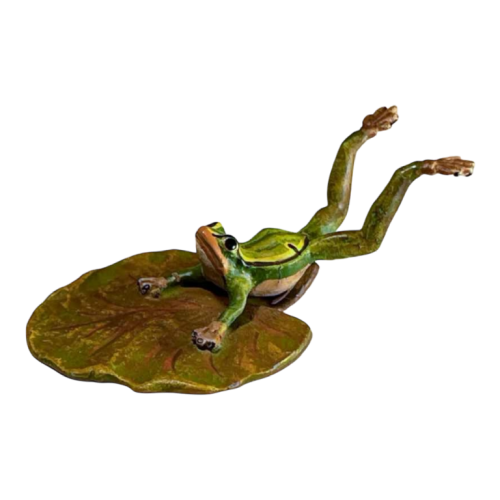Vienna Bronze “Diving Frog on a Water Lily” sculpture by Franz Bergmann in Vienna, c. 1900
Patinated bronze sculpture depicting a frog diving onto a water lily, produced in Franz Bergmann's workshop at the end of the 19th or beginning of the 20th century.
Signed underneath the piece (see photo) with Franz Bergmann's monogram.
Vienna bronzes produced by Bergmann are distinguished by their fine craftsmanship, polychrome patinas, and animal subjects presented with fantasy and humor.
- Artist / Designer:FRANZ BERGMANN (1838 - 1894).
- Signature / Monogram:Signed.
- Issuer / Manufacturer:BRONZE DE VIENNE.
- Stamp / Label:Yes.
- Period:20th Century.
- Country of Origin:Autriche.
- Dimensions (H x W x D):2cm x 2cm x 5cm.
- Weight:0,03 Kg.
- Condition:Excellent.
- Style:Other style.
- Material:Metal / Bronze / Patina bronze.
-
Price:SOLD
Biography:
Franz Bergmann (1861–1936) was the owner of a Viennese foundry that produced numerous miniature sculptures representing Oriental, erotic, and animal figures in bronze and patinated bronze. These pieces were often whimsical and humorous art objects with humanized traits.
His father came to Vienna and founded a small bronze factory in 1860. Franz Xaver Bergmann inherited the business and opened a new foundry in 1900. Many bronzes from the early 1900s were still based on designs from his father's workshop. His workshops temporarily employed numerous anonymous sculptors, including Bruno Zach, who asked Bergmann to cast some of his works, including certain erotic pieces signed “Prof. Tuch,” a pseudonym used by Zach.
Around the turn of the 19th century, there were approximately fifty similar workshops in Vienna producing “Vienna bronzes.” The term “cold-painted bronze” refers to pieces that were cast and then decorated in multiple layers with so-called dust paint, usually applied by women working from home.
The sensual poses of young women in Art Nouveau or Oriental style were discreetly disguised by clothing or drapery that would reveal themselves when a button was pressed or a lever moved. Many animals such as musical monkeys, hares, bears, foxes, frogs, etc., contributed to the fame of these workshops.
